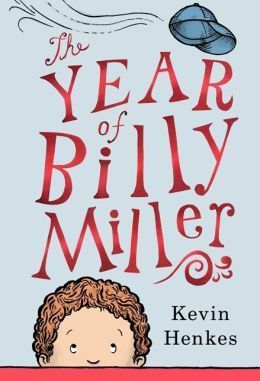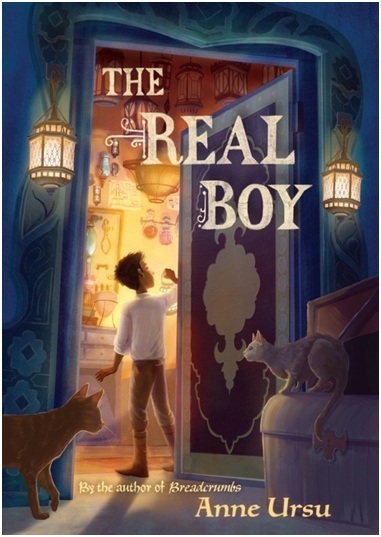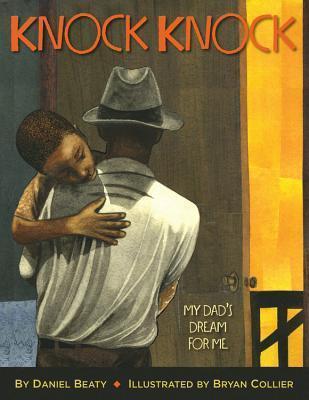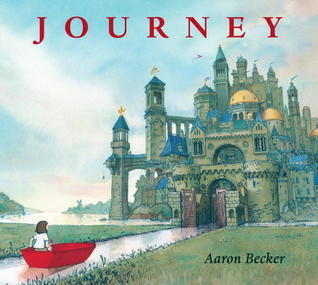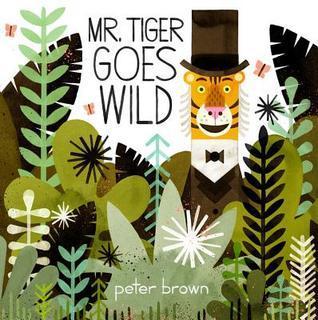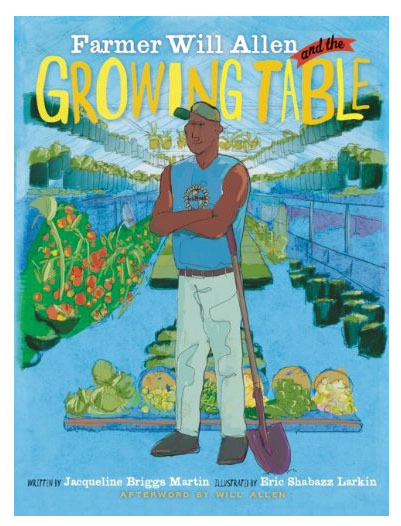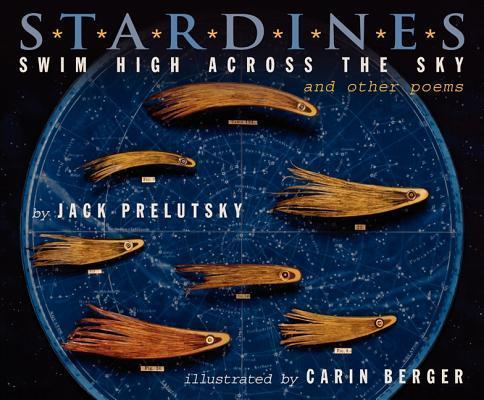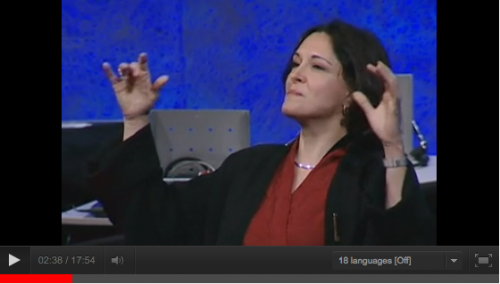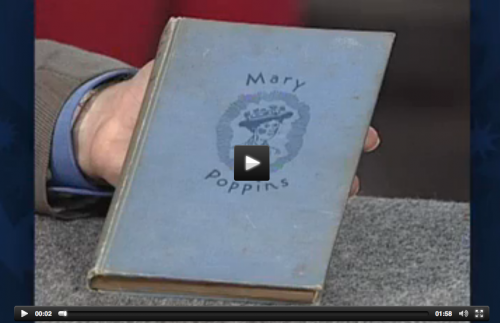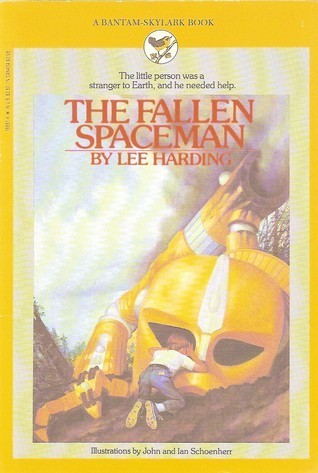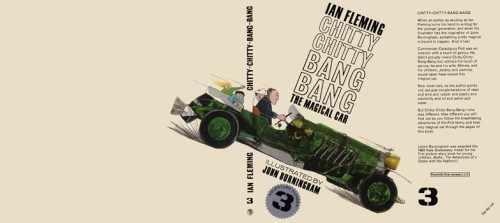Betsy Bird's Blog, page 304
September 20, 2013
Press Release Fun: Small Monsters
September 3, 2013
FOR IMMEDIATE RELEASE
FALL EXHIBIT AT ENTRYWAY GALLERY: “SMALL MONSTERS” New York, NY
Illustrators and fine artists were asked to mine their dark side and reveal the monsters that lurk there. Their responses, ranging from politically charged and literal to childlike and lyrical will be on display from Thursday October 3 through Sunday October 19 in “SMALL MONSTERS” at Entryway Gallery, located at 122 West 26th Street (between 6th & 7th Aves), Suite 1007 in the Chelsea/Flatiron District of Manhattan. (Subways: 1 to 28th St., F, M, C, E & 6 to 23rd St.) There will be an opening reception on October 3 from 5-8 pm.
Seventeen artists’ works will be on view, including:
×Czech-born Peter Sis, three time Caldecott Award winner, The New York Times Book Review illustrator, MacArthur Fellow, MTA artist and the author-illustrator of Starry Messenger, The Tree of Life, and The Wall: Growing Up Behind The Iron Curtain.
×Sci-fi illustrator and scholar Vincent Di Fate, known for his early pulp covers and iconographic paintings of famous monsters and horror characters, as well as a recent inductee by the Science Fiction Hall of Fame and former Society of Illustrators president.
×Bookmaker, sculptor and illustrator Frances Jetter, most recently seen as part of this summer’s Poets’ House exhibit, “Al-Mutanabbi Street Starts Here,” has contributed to The New York Times, The Washington Post, Time, The Village Voice, The Nation, and The Progressive.
Also contributing are graphic novelist Steve Ross, illustrators Sergio Ruzzier, Karen Gray Ruelle, Tim Bush, Jeff Seaver, Peter de Seve, Jeff A. Menges and Eric Fowler, art restorer and Entryway Gallery owner Jill Pratzon, printmakers Ann Marshall and Holly Elkins, as well as fine artists Beverly Brodsky, Barbara Gray and Peter McCaffrey.
To spur their creative process, gallery owner Jill Pratzon entreated the artists:“Do, do perpetuate the paranoid in you, the delusional, the ego-fueled maniac. Don’t believe them when they tell you nothing is wrong. Keep the monsters under your bed, and around each corner, and in the corners of both your eyes. They are your monsters, after all. They feed your crazy, spinning imagination. They will produce your works. Just get out of their way.”
Entryway Gallery’s fall show is an annual event sponsored by Pratzon Art Restoration, a studio specializing in the restoration and care of fine art and original illustration art for over sixteen years. Entryway Gallery showcases emerging and established artist-illustrators.
CONTACT: Jill Pratzon 212 807 7066 jill@jillpratzon.com EntrywayGallery.com
ENTRYWAY GALLERYat Pratzon Art restoration122 W 26 St. Suite 1007 NY, NY 10001
Press Release Fun: Children’s Media Association – Journeys to Publication
Got the flu this week and this weekend I’m speaking at the Eastern NY SCBWI Regional Conference as well as the Brooklyn Book Festival the next day. Hence the Press Release bonanza today. Hope it’s cool with you. I’m moderating this upcoming very fun panel. Hope to see you there!
 You have developed an idea for a book, or written a whole manuscript…now how do you get the book published? The publishing world is changing and much of what we hear is conflicting: “Ebooks are the future.” “The publishing industry is collapsing.” “Anyone can get published.” But what does this all mean?
You have developed an idea for a book, or written a whole manuscript…now how do you get the book published? The publishing world is changing and much of what we hear is conflicting: “Ebooks are the future.” “The publishing industry is collapsing.” “Anyone can get published.” But what does this all mean?
An author’s goal is to get their story into the hands of a reader and share their creation with a wide audience. The business of publishing is what takes a manuscript from an author’s computer and into a reader’s hands.
What is the best type of publishing for you brick and mortar publisher, self publishing or stay digital? We are bringing together 6 new young adult and middle grade authors who have been published in the last year to answer these questions and more. Join us for an enlightening evening as they discuss their varied adventures in publishing their first books.
Panelists include: Ame Dyckman (Boy and Bot), Lynda Mullaly Hunt (One for the Murphys), Joanne Levy (Small Medium at Large), Katherine Longshore (Gilt), Elisa Ludwig (Pretty Crooked), Sarvenaz Tash (The Mapmaker and the Ghost). The panel will be hosted by author, librarian, and popular blogger Betsy Bird.
More about our panelists:
Ame Dyckman
Ame Dyckman reads picture books when she’s supposed to be sleeping. Sometimes she
writes them by flashlight, too. Her recent books include:
• BOY + BOT, illustrated by Dan Yaccarino (Knopf; 2012)
• TEA PARTY RULES, illustrated by K.G. Campbell (Viking; October 3, 2013)
• WOLFIE & DOT, illustrated by Zachariah OHora (Little, Brown; Spring, 2015)
• HORRIBLE BEAR, illustrated by Zachariah OHora (Little, Brown; Fall, 2015)
Ame lives with her family and menagerie in Lawrenceville, NJ. Be sure to follow Ame on Twitter where she reviews picture books and Tweets random goofy thoughts.
Twitter: @AmeDyckman Website: http://www.amedyckman.com
Lynda Mullaly Hunt
Lynda Mullaly Hunt is the author of middle-grade novel, ONE FOR THE MURPHYS (Nancy Paulsen Books/Penguin), winner of The Tassy Walden Award: New Voices in Children’s Literature, an ABA New Voices Pick, and an Editor’s Choice Book with Scholastic Book Clubs. Lynda has also directed the SCBWI-NE Whispering Pines Retreat for eight years and is a former teacher and Scenario Writing coach. Her second novel, ALPHABET SOUP, will be released in spring, 2015. Lynda lives with her husband, two kids, impetuous beagle and beagle-loathing cat.
Twitter: @Lynmullalyhunt Website: http://lyndamullalyhunt.com/
Joanne Levy
Joanne Levy’s debut, a funny and sweet book for tweens, SMALL MEDIUM AT LARGE, was released from Bloomsbury in 2012. A survivor of the corporate world, Joanne is also a virtual assistant, providing admin services to busy authors via www.jlauthorservices.com. Joanne lives in Ontario, Canada with her husband and a lot of pets, one of whom vomited during the writing of this bio.
Twitter: @joannelevy Website: www.joannelevy.com
Katherine Longshore
Katherine Longshore is the author of GILT, a story of friendship and betrayal set in the court of Henry VIII and TARNISH, the story of a young Anne Boleyn. She has worked as a ship’s steward, a freelance travel writer, coffee shop barista and Montessori preschool teacher, but believes she has found her calling in writing novels for young people. She now lives in California with her husband, two children and a sun-worshiping dog.
Twitter: @KALongshore Website: www.katherinelongshore.com
Elisa Ludwig
Elisa Ludwig studied writing at Vassar College and Temple University, but she wanted to be a writer long before all of that—technically since she started writing, editing and publishing The Elisa Bulletin which she printed out on a dot matrix printer and sold for ten cents a pop. In the intervening years she has worked as a freelance writer, covering the following topics: hot dogs, insurance, cyber theft, penny-pinching, drug development, weddings, other people’s books, music, movies, restaurants, mental health issues, diets, engineering, whiskey, furniture, real estate and travel. But writing about teenagers is her favorite subject.She has been pick-pocketed twice, and once caught someone mid-pocket. Other than occasional jaywalking, she’s a law-abiding citizen. She lives in Philadelphia with her husband and son. PRETTY CROOKED is her first novel, and will be followed by PRETTY SLY in 2014, and PRETTY WANTED in 2015.
Twitter: @elisaludwigya Website: http://www.elisaludwig.com/
Sarvenaz Tash
Sarvenaz Tash was born in Tehran, Iran and grew up on Long Island, NY. She received her BFA in Film and Television from New York University’s Tisch School of the Arts. This means she got to spend most of college running around and making movies (it was a lot of fun). She has dabbled in all sorts of writing including screenwriting, copywriting, and professional tweeting. Sarvenaz currently lives in Brooklyn, NY. THE MAPMAKER AND THE GHOST is her debut novel.
Twitter: @sarvenaztash Website: www.sarvenaztash.com
More about our moderator:
Betsy Bird
Betsy Bird is New York Public Library’s Youth Materials Specialist. She runs the popular children’s literary blog A Fuse #8 Production, hosted by School Library Journal, and reviews for Kirkus and The New York Times on occasion. Bird is the author of the picture book GIANT DANCE PARTY, released this past spring, and she has an upcoming adult title with Candlewick coming out in 2014 called WILD THINGS: ACTS OF MISCHIEF IN CHILDREN’S LITERATURE which she wrote with fellow bloggers Jules Danielson and Peter Sieruta.
Twitter: @FuseEight Blog: http://blogs.slj.com/afuse8production/
Registration will open for Members on Tuesday, September 17, 2013. Register here.
Registration will open for Non-members on Wednesday, September 18, 2013. Register here.
Get the conversation started! Tweet #CMANewAuthors and tell us what you think!
September 18, 2013
Review of the Day: Aesop in California by Doug Hansen
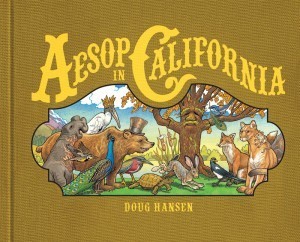 Aesop in California
Aesop in California
By Doug Hansen
Heyday
$16.95
ISBN: 978-1-59714-235-9
Ages 3-7
On shelves now.
Gather round me, o ye little children, and hear the tale I tell. Of a time when fairytales and folktales were as ripe and plentiful as the grapes of summer. When you could walk into any bookstore or library and pluck ten of the newest from the shelf so as to compare and contrast their relative merits. Twas a bonny era, and too short indeed. For years these tales have become rarities, difficult to find and even more difficult to publish. But wait! There is hope for us all. For as the great big publishers merge and combine to become capable of competing with the likes of Amazon.com, it is the little publishers that have seen this for what it really is: A glorious niche market. Now folks like Barefoot Books, minedition, Albert Whitman, and more have swept in and filled what was once a huge gap in our collections. In 2013 alone we’ve seen the publication of no less than four different Aesop fable collections. And the best of these? An unassuming but ripe and rich little book called Aesop in California by Doug Hansen. Far more than just a local interest piece for native Californians, Hansen has pinpointed what it is about Aesop that is perfectly adaptable to every nation and age. American to its core and meticulously researched, this is an equal tribute to stories that have lasted the centuries, and to a state that Hansen loves so very well.
Fifteen of Aesop’s fables are plucked from his roster and adapted to the Californian landscape. Are you familiar with “The Lion and the Mouse”? Well then meet a version where it’s a mountain lion and a deer mouse. “The Fox and the Grapes” one of your favorites? Well consider how much sense it makes to place that story in the Napa Valley. With keen insight and forethought Hansen adapts each of his stories with an eye to both the past and the animals of the present. Hares become jackrabbits, crows are magpies, and bulls become male elephant seals (also known as bulls). A heady Introduction begins the collection, and it is followed at the end by Fabulous Facts about each story.
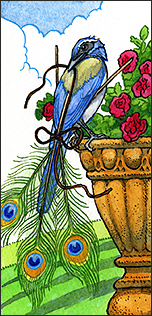 I’m a New York City librarian. I’ve visited almost every one of our 90 some branches in Manhattan, Staten Island, and the Bronx. My workplace sports big stone lions out front. I take the subway to work. And the only time I make it to California is when there’s a library conference there. Doug Hansen, in contrast, is California born, bred, and raised. He was born in Fresno, he went to school in Fresno, and he teaches illustration in Fresno. He published Aesop in California with a little outfit called Heyday, which pronounces proudly that their purpose is to “promote wide-spread awareness and celebration of California’s many cultures, landscapes, and boundary-breaking ideas.” So you might not think we’d have all that much in common, Mr. Hansen and I. But that’s where you’re wrong, friend. For though my interest in California is slim to none, I am VERY interested in both Aesop’s fables in any and every form and also a through accounting of American themes, history, and wildlife. And that, to my mind, is why Aesop in California is applicable above and beyond its location. While it’s wonderful that the common thread connecting everything here is a single state, the adaptations are clever, the writing wonderful, and the art magnificent. There is therefore no reason in the world why every library in this great nation of ours shouldn’t have a copy on their shelves.
I’m a New York City librarian. I’ve visited almost every one of our 90 some branches in Manhattan, Staten Island, and the Bronx. My workplace sports big stone lions out front. I take the subway to work. And the only time I make it to California is when there’s a library conference there. Doug Hansen, in contrast, is California born, bred, and raised. He was born in Fresno, he went to school in Fresno, and he teaches illustration in Fresno. He published Aesop in California with a little outfit called Heyday, which pronounces proudly that their purpose is to “promote wide-spread awareness and celebration of California’s many cultures, landscapes, and boundary-breaking ideas.” So you might not think we’d have all that much in common, Mr. Hansen and I. But that’s where you’re wrong, friend. For though my interest in California is slim to none, I am VERY interested in both Aesop’s fables in any and every form and also a through accounting of American themes, history, and wildlife. And that, to my mind, is why Aesop in California is applicable above and beyond its location. While it’s wonderful that the common thread connecting everything here is a single state, the adaptations are clever, the writing wonderful, and the art magnificent. There is therefore no reason in the world why every library in this great nation of ours shouldn’t have a copy on their shelves.
Though the publication page gives nothing away in terms of Hansen’s preferred style, it looks as though it was illustrated in the lushest possible watercolors. Each one is highly detailed, utilizing jewel-toned pictures replete with shockingly accurate settings. In his Acknowledgments section at the beginning of the book, Hansen describes the research trips he had to take to get these pictures right. When thanking a friend he says, “Without the research trips, I would have missed visual details like the carpet of acorns in `The Oak and the Reeds,’ the knee-high field of wheat in `The Meadowlark and Her Children,’ and the high-rise kelp pile in `The Elephant Seal and the Kelp Fly’.” Near every plant or animal he discovered makes a cameo in the book. At the same time, he pays very close attention to geography as well. On the back of the book you’ll find a map of California with animals from each fable located over the area where their story takes place. They’re evenly spaced out throughout the state over their respective locations. Then in the back of the book Hansen includes additional information about each illustration and tale.
Just looking at the book you can see from the start that the art is gorgeous. That’s a given. But let’s credit Hansen with his writing as well. First off, I really appreciated the fact that in his Introduction he covers not just the historical figure of Aesop but the history of the publication of his fables, but the fact that the “morals” at the end were found in later iterations of the tales not the originals. I’ll admit to you right here and now that I’m no Aesop purist and I sort of need the morals some of the time. Hansen does include these morals, but he has also re-written the tales so that they would fit with their themes. One example of this is in “The Prospectors and the Bear”, which re-imagines the story as a true snippet of American history. The clever intersection of history with an old fable is great, but the dialogue and writing itself is really delightful as well. You could certainly have counted on Hansen to draw beautifully, but who knew he was such a great writer as well?
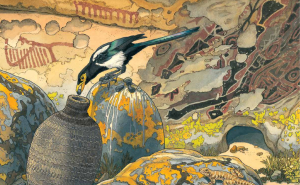 I should like to make note of my favorite story in this collection. That would be “The Magpie and the Basket Bottle”. Aside from the fact that I’ve always liked the original story, I just love love love the art here. Changing the main character from a crow to a magpie isn’t much of a stretch. Then you have the Californian deserts to attest for the magpie’s desire for liquid refreshment. But I was particular fond of the fact that this is one of the images that really acknowledges the history of California state above and beyond the usual Hollywood/Gold Rush narrative. The magpie finds a basket bottle with liquid in it that was created by the Chumash people. In his notes at the end, Hansen then explains what items the magpie is dropping in (“Chumash shell beads, shirt weights, and arrow straightener”) to make the water level rise. He even gets into how the Chumash people melted powdered tar in their baskets to make them waterproof, and includes a picture of one of their pictographs in the background. Considering how often Native people are forgotten when folks recap the history of his nation, I was mighty relieved at the inclusion.
I should like to make note of my favorite story in this collection. That would be “The Magpie and the Basket Bottle”. Aside from the fact that I’ve always liked the original story, I just love love love the art here. Changing the main character from a crow to a magpie isn’t much of a stretch. Then you have the Californian deserts to attest for the magpie’s desire for liquid refreshment. But I was particular fond of the fact that this is one of the images that really acknowledges the history of California state above and beyond the usual Hollywood/Gold Rush narrative. The magpie finds a basket bottle with liquid in it that was created by the Chumash people. In his notes at the end, Hansen then explains what items the magpie is dropping in (“Chumash shell beads, shirt weights, and arrow straightener”) to make the water level rise. He even gets into how the Chumash people melted powdered tar in their baskets to make them waterproof, and includes a picture of one of their pictographs in the background. Considering how often Native people are forgotten when folks recap the history of his nation, I was mighty relieved at the inclusion.
We all have our favorite Aesop collections (we do, right?) and they vary widely. Aesop is all things to all people. A perpetual font of wisdom that reflects our own times. His stories are plucked out and turned into individual picture books all the time (think of the relatively recent Caldecott Award win The Lion & the Mouse by Jerry Pinkney as one such example). So it does my heart good to see Doug Hansen pouring so much of his heart and soul into a book like this. Our kids deserve only the best possible books. The ones that have been perfected within and inch of their lives. Hansen has done precisely that and the result is a book that’s going to enchant kids above and beyond the borders of his impressive little state. It may be called Aesop in California but this is an American Aesop at its core, and a book with universal appeal. Go get that thing.
For ages 3-7.
Source: Checked out copy from library for review.
Like This? Then Try:
Aesop’s Fables by Aesop, ill. Ayano Imai
Arctic Aesop’s Fables: Twelve Retold Tales by Susi Gregg Fowler
Aesop’s Fables by Ann McGovern
Professional Review: Kirkus
Other Reviews: L.A. Parent
September 16, 2013
Newbery / Caldecott 2014: Fall Prediction Edition
Now that Heavy Medal and Calling Caldecott have been revving their proverbial engines, my idle speculations and fantasies get a bit more oomph. The nice thing is that nothing Heavy Medals has discussed so far strikes me as a serious contender (except the Spinelli, of course). I’m also choosing to post this the same morning that the National Book Award longlist is announced at 9 a.m., so it would probably have made a certain amount of sense to wait another day. Then again, the National Book Awards are like oil and water to the ALA given awards. They rarely mix.
It should also be said that out of all my prediction editions, fall has the worst track record. Spring, for whatever reason, tends to have the best so you can always go back and read that one if you’ve half a mind to do so. Last year around this time I had discounted Ivan (I later recanted), dismissed Three Times Lucky, and the only thing I got right on the Newbery side was a mention of Splendors and Glooms. Not exactly groundbreaking or insightful. Caldecott fared slightly better with inclusions of Green and Extra Yarn but I said of This Is Not My Hat, “No, I’m afraid his work on Extra Yarn has a better chance. This one is a visual stunner, but not quite there on the writing side.” [enter sad trombone music here]
So with that knowledge in your back pocket . . .
NEWBERY 2014
Doll Bones by Holly Black – I’m not changing my mind on this one. Nope. Not happening. Still the one that I want. I’ve seen other folks mention that it does what Hokey Pokey did, but many people prefer Black’s singular take. In an interesting sidenote, my assumption that the creepiness of the doll would outweigh the fact that it is, in fact, a doll was apparently misplaced. I felt positive that significant numbers of boys would pick this up thanks to the word “Bones” in the title and the fact that the doll looks half inclined to smother you in your sleep. I guess she should have had the creep factor increased, though, since a run through of patrons with the book out in my system shows that the ratio of girls to boys is about 8:1. Bummer. Hopefully a nice bright shiny medal would overcome that problem.
The Water Castle by Megan Frazer Blakemore – It’s possible that at first I mentioned Blakemore’s book because it was early in the year and the surprise of it shocked me into an inclusion. Time has passed since I picked it up. At least half a year has gone by since I read it, and yet the characters are as fresh and clear in my mind as they were when first I picked up its pages. It’s science fiction, a format that has only won the Newbery Award proper five times before (I’m counting The Twenty-One Balloons – you are free to try to determine what the other four were) so that’s against its favor certainly. Still and all, I think it can, I think it can, I think it can . . .
Africa Is My Home: A Child of the Amistad by Monica Edinger – It’s official. 2013 is officially a bad nonfiction year for the Newbery. While it is possible a The Mad Potter: George E. Ohr, Eccentric Genius by Jan Greenberg & Sandra Jordan or a Courage Has No Color by Tanya Lee Stone might slip in, the odds are not as strong as I would like. The closest we can come to a possibility is Edinger’s fictional take on a nonfiction event. Concerns that I’ve heard surrounding the book verge on the mildly ludicrous so far, so it may turn out to be a serious contender. One to watch a little more closely, certainly.
Salt by Helen Frost
As it happens, I wouldn’t actually call this book the most talked about story about historical Native Americans of 2013. That honor falls upon Susan Cooper’s well-meaning and unfortunate Ghost Hawk. But where Ghost Hawk feels more like a too long amalgamation best suited to an adult readership, Frost (who has never received sufficient praise for her books, though they come up in Newbery discussions all the time) nailed it here. Salt utilizes her verse format to a good end, the history is dead on, and the characterizations manage in their brief amount of time to ring real and true. One to discuss, at the very least.
The Year of Billy Miller by Kevin Henkes – I’ve raved about it in the past and the book will hit shelves on 9/17 so soon you’ll all be able to see what I’ve been talking about. I guess the name of the game for me this year is “succinct”. I’m tired of overblown unedited novels for children. Give me something that manages to contain heart and hope without 300+ pages. To my mind, Henkes epitomizes what the Newbery should really be about. He captures a soul on a page. No mean feat. This might be my frontrunner now.
Hokey Pokey by Jerry Spinelli – I was tempted to drop this one from the list, but I just can’t seem to do so. I know it’s impenetrable for some. And maybe by the time we hit the end of the year I won’t be able to truly believe it has a fighting chance, but there’s something about Hokey Pokey that keeps me from abandoning it. I suspect it’s the plum good writing. Hard to ignore that sort of thing.
The Real Boy by Anne Ursu – If you read the recent comment section at Heavy Medals regarding autism and the fact that, as Jonathan Hunt says, there are “no less then three high profile books that we will likely consider here: NAVIGATING EARLY, THE REAL BOY, and COUNTING BY 7s” then this is just another trend. However, this is the only one of those three that I’d consider the real contender. Navigating Early must contest with its size, the reported math mistakes, and the question of whether or not Early constitutes a convenient literary foil or a real character. Counting By 7s, by the same token, has to handle questions of race (the main character seems so arbitrarily assigned to a race other than white that it feels like an editorial note rather than the writer’s plan) even as it contains what may be my favorite character of the year (the guidance counselor). Compare these then to The Real Boy which manages to cleverly weave in adult themes (the addiction to magic, fear of losing a child leading you to foolish choices, etc.) in an interesting and child-friendly setting. What’s more, the character development feels like it’s at the heart, rather than the periphery, of the fantastical elements. Yeah. This one’s a keeper.
Potential Wild Cards: This is preee-cisely the kind of year likely to garner Honors for books like The Boy on the Porch by Sharon Creech, or the TWO Patricia MacLachlan books The Truth of Me and White Fur Flying. I wouldn’t blink so much as an eye if any of these suddenly won it out of the blue. But I haven’t committed to any one of these three as a surefire winner yet. That may be telling in and of itself.
Fun Fact: I kid you not when I tell you that one of the top search terms leading folks to my blog this year is the term “Far Far Away too scary Newbery”. More than any other YA novel of 2013, this one is the one folks keep mentioning in terms of Newbery potential. I had a very visceral reaction to the book, which colors my interpretation of it. The ending was so dark and bleak (I have this thing against child torture) that it really made the entire outing unpalatable to me. This is not to say it is poorly done. And there are scenes (pleasant ones) that have stayed with me. That said, I do believe that the content renders it for the 14+ crowd, and I’ve nightmares of parents reading the plot description and handing the book to their nine-year-old readers saying, “Look, honey. It’s a Newbery winner about fairy tales. You love fairy tales!” So I do hope it hasn’t a chance in blue blazes. The Printz may be another matter entirely.
CALDECOTT 2014
Building Our House by Jonathan Bean – I wonder. It’s a personal story and it could just be that when it came out early in the year it blew us away. That said, I feel like it stands out. A huge point in its favor is the fact that it’s really kind of unlike anything else I’ve seen before. The idea of seeing a family making their own domicile . . . it has the potential to blow the minds of the children that read it. Worth considering at least for a little longer.
Knock Knock: My Dad’s Dream for Me by Daniel Beaty, ill. Bryan Collier – The greatest point against it may be its release date. Slated to come out on December 1st, it risks being wholly and entirely forgotten by the Mock Caldecotts by dint of its late release. Heck, when Calling Caldecott released their list of books to read, Beaty’s title was nowhere in sight (not that it could have been with that date). Bear in mind that Collier won a Caldecott Honor not that long ago (and for nonfiction!) and here he’s actually expanded his style. It’s not straight realism at work. In fact, I think it’s his best book in years, above and beyond the message itself. Don’t you forget about this one.
Journey by Aaron Becker – If there’s a frontrunner, this would be it. If you need a refresher there is this absolutely lovely book trailer out there to remind you. Becker’s a debut author/illustrator, but that’s hardly unheard of in terms of the Caldecott. Debuts have won before. This one’s wordless and Caldecott committees sometimes go goofy for that particular format. My money is still riding on Becker then. It’s my only surefire bet on this list.
Mr. Tiger Goes Wild by Peter Brown – Little odd that I haven’t reviewed this one yet. Note to Self: Right this wrong. By this point I’ve read this book to my 2-year-old countless times and it really does stand out. I think I may have mentioned before that the only real objection I’ve heard about it (aside from the last 2-3 pages, which is entirely subjective) is that the style is similar to Jon Klassen. Pshaw, sez I. That wordless two page spread is nothing but Miss Rumphius all the way, and that ain’t small potatoes.
The Matchbox Diary by Paul Fleischman, ill. Bagram Ibatoulline – Now I’m making the assumption here that Mr. Ibatoulline is living in America, but that could be far from the truth. Mind you, I’ve mentioned this book in two of my previous round-ups and no one has raised this point as a potential objection to his win. Could be nobody knows where he lives. If he does live here, I don’t see how this isn’t in the top five of the contenders.
Locomotive by Brian Floca – You all know well and truly my love for this book and my fears that like his other nonfiction books it will be passed over by the Caldecott committee. Some days it feels like only the Sibert loves Mr. Floca. That said, this is his best work yet and it would be a crime against man, woman and child if it were forgotten. *fixes committee with a cold hard stare*
The Boy Who Loved Math: The Improbable Life of Paul Erdos by Deborah Heiligman, illustrated by LeUyen Pham – I’m probably just whistling in the wind on this one. Nothing this factual and fun could win a Caldecott, right? But if “distinguished” is what you seek, look ye no further. The incorporation of math within the art is extraordinary. It should really get some love.
Farmer Will Allen and the Growing Table by Jacqueline Briggs Martin, ill. Eric-Shabazz Larkin – Unlike the Newbery, the nonfiction picture book side of things is remarkably strong this year. Melissa Sweet’s A Splash of Red could sneak up on us and The Tree Lady certainly caused my jaw to drop and then bounce across the floor. But in the end I harbor the greatest fondness for Martin’s latest. It isn’t just the fact that she’s one of the rare nonfiction writers to have penned a nonfiction Caldecott winner, but Larkin’s art is really lovely. It’s not just the pictures either. The incorporation of text and the design of certain words just felt good every step of the way.
The Mighty LaLouche by Matthew Olshan, ill. Sophie Blackall – Am I crazy? Or do I just want Blackall to win something one of these days? I think the three-dimensional effect here is worth mentioning, particularly since its use makes sense in the context of the book. And speaking for working in more than two dimensions . . .
Stardines Swim High Across the Sky by Jack Prelutsky, illustrated by Carin Berger – You’ll figure out at this point that this list basically just consists of people who haven’t won the Caldecott before that I feel really deserve it. I like repeats sure, who doesn’t? But what I really adore is when the deserving who have worked in the field for years get their just desserts. And this book is more than just dessertable.
Potential Wild Cards: I wouldn’t take your eye off of Uri Shulevitz if I were you. His Dusk is one of those books that sneaks up on you, and could easily blow the competition out of the water if the committee were so inclined. It would take a brave committee to commit to Mr. Wuffles by David Wiesner, a fun book but one that even my comic book minded husband had some difficulty following. And I’d love it if God Got a Dog by Cynthia Rylant, illustrated by Marla Frazee won the day, if only because it’s a funny one. Unlikely as all get out, but Frazee has a serious charm offensive. She could pull it off.
So what do you like?
September 15, 2013
Video Sunday: Itching powder out of rose hips and other Dahlian artifacts
I forget how many years ago it was, but in the not so distant past (I’m going to go out on a limb and say it was 2009) I had the pleasure of hosting children’s author and storyteller Carman Agra Deedy in my Children’s Center. Talk about a storyteller! She will hold you riveted from syllable one onwards. I had no idea that back in 2005 she did a TED talk. Had I known, I would have posted it long before now. Here goes:
Thanks to Aunt Judy for the link.
Clever move, author Sue Fleiss. One thing I would like to point out about this video before you watch it is that it involved picture book related hand jive. No easy task.
Catchy.
I’ve decided that the last great children’s literature world to delve into and learn more about has got to be the world of collecting. I don’t know much of any children’s book collectors and I think they’d be fascinating folks to mingle with. That in mind, when I heard that Travis Jonker had gotten this Antiques Roadshow clip from John Schumacher it all seemed to click. I wish I knew what made a children’s book valuable. I tremble when I think about the titles we handle on a regular basis in my office.
It’s probably no surprise to you to hear that a fair number of folks contact me about including videos of their authors or illustrators on this site. I don’t always say yes, but I always watch to see if the videos are honestly interesting. And brother, this brief interview with Fred Bowen is precisely that. I’ve always been a bit sports allergic myself, so to hear him pinpoint the value of the “culture” as he (rightly) puts it is good for me.
Don’t think I’ll actually embed anything from this site, but it’s worth knowing about in any case. Storyline Online is is odd little online streaming video program where you can watch various members of the Screen Actors Guild read old children’s books. As of right now the readers include Betty White, Melissa Gilbert, Sean Astin, Elijah Wood, Jason Alexander, Ernest Borgnine, James Earl Jones, Robert Guillaume, Tia & Tamara Mowry, etc. I have to assume they haven’t done many recently, if only because the books themselves are pretty old. At any rate, its an interesting smattering. Thanks to Aunt Judy for the link.
Well. This is . . . just the more frigging adorable thing. Check it.
Sort of combines all my favorite things. Cute kids speaking languages other than English and world-renowned cartoonists we’ve never heard of. Liniers. I’ll remember that name now.
In other book trailer news, it’s awful nice when your illustrator not only creates the art for your book but comes up with some catchy song tie-ins as well. Case in point:
And now some thoughts.
1. There is a Roald Dahl bio by Michael Rosen and it’s not available in the U.S.? This thing cannot be right.
2. The following video is 45 minutes long and rather worth it. This is a vid that was streamed live on Tuesday.
3. Rosen. He doesn’t flub. Not a word, not a syllable. This man is a practiced pro. I would rather like to be him when I grow up. I wonder if he’s ever done a TED talk . . .
4. If you would like to hear musical performances from shows like Matilda, you can see the Matilda song around 15:30. 19:44 is where you’ll find the backstage peek into the new Charlie and the Chocolate Factory musical. No live performances there, sadly.
And for our off-topic video of the day, this would be the video that garnered the most alerts to my attention from family and friends this week. There are people that say it’s the Gangnam Style of 2013. Don’t know about that, but it is rather children’s literature friendly (so maybe it’s only 85% off-topic). Thanks in particular to Kate and Marci for the link.
September 13, 2013
Review of the Day: Monster on the Hill by Rob Harrell
 Monster On the Hill
Monster On the Hill
By Rob Harrell
Top Shelf Productions
$16.28
ISBN: 978-1-603090759
Ages 8-12
On shelves now
See, people? *shakes book in the air* How hard is this, really? I stand beside thousands of children’s librarians who have, for years now, been in a bit of a pickle with the kiddos when it comes to great graphic novels. I blame Bone. If Scholastic hadn’t rereleased Jeff Smith’s classic series in full color editions and marketed them to kids, we wouldn’t have had to face wave upon wave of impressionable children holding up their worn and battered editions saying, “Do you have anything like this?” Because crazy as it might sound, the answer is usually no. You want kid-friendly fare that’s adventurous AND funny? And full-color? Uh . . . suuuuure, kid. To be fair, some books fit the bill. Thanks to Giants Beware! by Jorge Aguirre, Sidekicks by Dan Santat, and Jellaby by Kean Soo I’ve managed to feed their hunger, but nothing’s ever been enough. So it is with great rejoicing and the throwing of small pieces of confetti that I welcome to my shelves the fast, funny, not so furious Monster on the Hill by Rob Harrell. There is nothing here your children won’t love. Heck with it. There’s nothing here YOU won’t love.
Every good town has a good monster. They’re fantastic. Much of the time they’re terrorizing the citizenry, and as everyone knows that’s just good for business (tourists love to be terrified). Best of all, a good monster will guard a town from a threat known only as The Murk. And then there’s poor Stoker-on-Avon. They’ve a bit of a monster problem. His name is Rayburn and . . . well, let’s be honest. Rayburn’s kind of pathetic. Worst of all, he knows it, so his days are spent wallowing in self-pity. When Dr. Charles Wilkie is charged by the town fathers to perk the creature up he unwittingly brings along plucky newsboy orphan Tim. Together, the three try to get at the root of Rayburn’s problem. Unfortunately a trip to his friend Tentaculor leaves Stoker-on-Avon without a guardian. And The Murk? He’s hungry . . . very hungry . . .
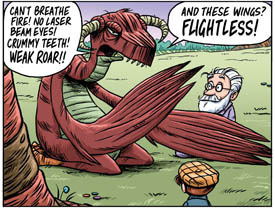 What do you talk about first when you’re reviewing a graphic novel? I don’t really have a rote set of talking points in a distinct order. That said, I’ve the vague sense that I probably should. I feel that way because my instinct right now is to begin by talking about the colors in this book, which is kind of an odd choice. But see, kids these days are spoiled. They love their comics to be full-color, an expensive and time-consuming proposition most of the time. With the exception of fabulous independents like Matt Phelan (Bluffton) most comic book artists for kids don’t dabble in things like watercolors or pastels. They rely on good old-fashioned computer coloring. Trouble is, there’s excellent computer coloring and then there’s the lousy variety. Lousy is easier to do so you’ll it much more often. Now Top Shelf didn’t deem it necessary to list in this book whom the colorist might be (perhaps it was Mr. Harrell himself?), but whoever it might have been they did a top-notch job. The colors in this book are understated without being muted. They match the storyline perfectly. Not every graphic novel can say the same.
What do you talk about first when you’re reviewing a graphic novel? I don’t really have a rote set of talking points in a distinct order. That said, I’ve the vague sense that I probably should. I feel that way because my instinct right now is to begin by talking about the colors in this book, which is kind of an odd choice. But see, kids these days are spoiled. They love their comics to be full-color, an expensive and time-consuming proposition most of the time. With the exception of fabulous independents like Matt Phelan (Bluffton) most comic book artists for kids don’t dabble in things like watercolors or pastels. They rely on good old-fashioned computer coloring. Trouble is, there’s excellent computer coloring and then there’s the lousy variety. Lousy is easier to do so you’ll it much more often. Now Top Shelf didn’t deem it necessary to list in this book whom the colorist might be (perhaps it was Mr. Harrell himself?), but whoever it might have been they did a top-notch job. The colors in this book are understated without being muted. They match the storyline perfectly. Not every graphic novel can say the same.
Then there is the writing. Can we talk timing for a bit here? Because when it comes to pacing, Monster on the Hill knows what it’s doing. The beginning starts with a big old bang. There’s wanton destruction and people running for their lives. It’s delightful. As the book progresses, Harrell harnesses his storyline perfectly. Clearly he has the storytelling gene. That’s great. But how are the jokes? We are, after all, talking about a syndicated cartoonist. He’s been in the business more than a decade but does that funny translate to the book format? You bet your sweet bippy it does. All hail Looney Tunes and other cartoons that established the perfection of the visual gag. Time and again Harrell gets the maximum enjoyment out of the silent frame followed by the funny line or the incredibly ridiculous moment couched in seriousness.
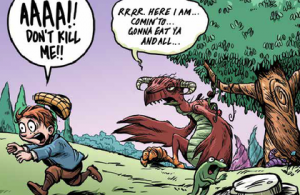 It isn’t all timing, though. Many of the jokes in this book are visual gags or just honestly funny sentences. Seeing The Murk, the ultimate bad guy, sniffing fear from the townspeople and then saying, “Oh, yeah. That’s the good stuff” is delightful. The smaller jokes are less noticeable. Notice what happens to Wilkie’s carriage driver when the gleesome threesome decides to take a road trip. Then there’s the fact that the town fathers have names like “Mr. Hawthorne”, “Mr. Shelley” and “Mr. Stevenson”. Additional Bonus: The town is “Stoker-on-Avon”. Few kids are going to pick up on any of this (few adults too, I suspect) but they’re there for anyone interested.
It isn’t all timing, though. Many of the jokes in this book are visual gags or just honestly funny sentences. Seeing The Murk, the ultimate bad guy, sniffing fear from the townspeople and then saying, “Oh, yeah. That’s the good stuff” is delightful. The smaller jokes are less noticeable. Notice what happens to Wilkie’s carriage driver when the gleesome threesome decides to take a road trip. Then there’s the fact that the town fathers have names like “Mr. Hawthorne”, “Mr. Shelley” and “Mr. Stevenson”. Additional Bonus: The town is “Stoker-on-Avon”. Few kids are going to pick up on any of this (few adults too, I suspect) but they’re there for anyone interested.
Now don’t get me wrong. The setting of this book is odd. First off, it exists in that odd time period where everything’s just barely pre-Industrial Revolution but folks can still make jokes about Hot Pockets. Then there’s the location. One has to assume that we’re in Britain here. As such, certain characters exhibit distinctly English tendencies in their speech. And by rights the mix of semi-British English with completely contemporary words and phrases should, by its very definition, jar. I just . . . doesn’t. I suppose I’m a poor judge. My favorite moments on The Simpsons are when Bart adopts a faux Cockney accent. Spunky (Cockney) orphan Tim fills that same need.
Rob Harrell is, at this time, best known for his comic strips “Adam @ Home” and “Big Top”. Like fellow cartoonist Stephan Pastis (“Timmy Failure”) he’s extended his talents this year and is garnering a new readership. Kids that have never even seen a newspaper comic, let alone read them, will be instantly hooked by Harrell’s kooky storyline and good-natured monstering. For those kids who want something adventurous and amusing, their prayers will be answered. Granted, for the most voracious amongst them this book will take up a single hour of reading (maybe less). At least it’s fun while it lasts. Monster On the Hill. Get your own.
On shelves now.
Source: Title borrowed from the library for review.
Like This? Then Try:
Jellaby by Kean Soo
Giants Beware by Jorge Aguirre
Sidekicks by Dan Santat
Bone: Out of Boneville by Jeff Smith
Professional Reviews:
A star from Kirkus
Publishers Weekly
Other Reviews:
Multiversity Comics
Splice Today
Broken Frontier
The Trades
Geeks of Doom
Read About Comics
A.V. Club
Ain’t It Cool News
iFanboy
North Adams Transcript
September 12, 2013
Press Release Fun: The Children’s Book Council Steps It Up a Notch
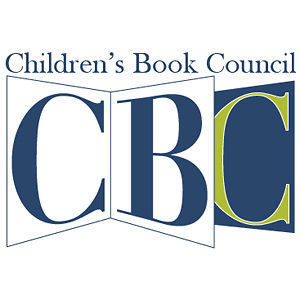 While technically this isn’t a proper press release, I think it’s worth noting. I once conducted a Children’s Literary Salon at NYPL about alternative children’s libraries in New York City. Libraries that are free and open to the public, but you have to know about them. The Children’s Book Council’s library was amongst those included. Here then is some news on their newest site. Please make note of the Job Openings section in particular:
While technically this isn’t a proper press release, I think it’s worth noting. I once conducted a Children’s Literary Salon at NYPL about alternative children’s libraries in New York City. Libraries that are free and open to the public, but you have to know about them. The Children’s Book Council’s library was amongst those included. Here then is some news on their newest site. Please make note of the Job Openings section in particular:
A brand-new version of the CBC site is now live at www.cbcbooks.org!
Some features that might be of particular interest to you:
· A search function for our reading lists and round-ups that will enable parents/caregivers, teachers, librarians, and booksellers to easily find the perfect books for their young readers. As you can see, there are options to search by age, format, genre, Seasonal Showcase theme, & by Children’s Choice Book Awards Winners. Additional functionality that will enable visitors to search for a book that falls within as many categories as they select is coming soon.
· For all books featured on our site, we now have the ability to embed the book trailer and to link to more information/a preferred purchasing site for the title. See example here.
· A showcase for titles featuring diversity on our home page (curated by CBC Diversity), and in our reading lists section here
· Under Reading Lists, a new section detailing all the previous winners and finalists of the Children’s Choice Book Awards
· A detailed FAQs section designed to help aspiring authors and illustrators, non-member publishers, and more visitors to our site find the information they need
· A comprehensive (nearly!) archive of all of the job moves at our member publishing houses over the last few months
· Online newsletter sign-up for both members and the kid lit community at large
· and much more
Continued features include:
· Kid lit news – the best in children’s and young adult literature and literacy news!
· Kid lit events – fun children’s and young adult literature events from coast to coast!
· Job openings – recent job openings at our member publishers
September 11, 2013
Fusenews: Berries of new, cots of Cal.
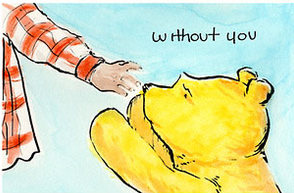 Today I shall begin by ripping out your heart and stomping it into tiny shreds upon the floor. You may be aware that for years I have worked with the real Winnie-the-Pooh toys at NYPL. You may also know that the real Christopher Robin had a serious falling out with his father about the books. Now Ian Chachere has written was is easily the BEST graphic story about Christopher Robin at the end of his days. Thank you for the link, Kate.
Today I shall begin by ripping out your heart and stomping it into tiny shreds upon the floor. You may be aware that for years I have worked with the real Winnie-the-Pooh toys at NYPL. You may also know that the real Christopher Robin had a serious falling out with his father about the books. Now Ian Chachere has written was is easily the BEST graphic story about Christopher Robin at the end of his days. Thank you for the link, Kate.Well, get out your fire hoses and start running for the hills (I prefer my mixed metaphors shaken, not stirred). The Newbery/Caldecott prediction season is about to begin 4 realz. Calling Caldecott is gently starting its engine, checking its rear view mirror, and making sure the gas tank is full. Heavy Medal, meanwhile, is putting pedal to the medal (so to speak), revving this puppy as loud as it can go, and then tearing down the street leaving only burnt rubber and flames in its wake. If you have favorites, they will be systematically destroyed (even, God help us, Doll Bones if Nina’s comments are any indication). Personally I’m just biding my time until Jonathan Hunt attempts to defend Far Far Away as a Newbery contender.
Speaking of the berry of new, Travis Jonker is churning out the fun posts on Newbery stats. They remind me of the glory days of Peter Sieruta (he loved these sorts of things). Want to win a Newbery of your very own? Then you’d better check out So You Want to Win a Newbery, Part 1 and Part 2.
What causes the most problems in Greek mythology? The answer may surprise you (not really). My mom was right to point out that the last sentence should contain a he/she there.
Whenever I hear that a celebrity has written a children’s book my reaction isn’t so much outrage as a kind of resigned, “What took them so long?” In my perverted take on Andy Warhol’s famous quote, in the future everyone will have their own children’s book for 15 minutes. The latest not-so-surprising travesty is Rush Limbaugh’s are-we-absolutely-certain-this-isn’t-from-The-Onion book Rush Revere and the Brave Pilgrims . And we could pull out the usual jokes and all (certainly I’m highly tempted to buy a copy, if only to randomly quote from it on this blog to comedic effect from time to time) but it was Thom Barthelmess who classed the joint up recently by writing of it, “I believe that librarians can shape that discourse by modeling respect for those with whom we disagree. And I believe that every time we suggest to a child that her book choice is inappropriate we weaken the foundation on which she is building a life of reading. This, my friends, is where intellectual rubber meets the freedom road. Let’s be sure we’re holding the map right-side up.”
How did I miss this? Last year I did indeed notice the plethora of Chloes. So why didn’t I see the abundance of 2013 Floras? Fortunately Elissa Gershowitz at Horn Book was there to pick up my slack.
Good old Common Core. It’s so common. So core-y. Over at Publishers Weekly their inaugural Common Core column has posted. It’s called Cut to the Core: Distinguishing Common Core Myth from Reality. Check it.
Speaking of Common Core, not too long ago I gave a talk about it at a New Jersey SCBWI Conference. Now over at 1600 Words a Day, author Amy Armstrong summarizes me with a Snapshot of Betsy Bird’s Session on the Common Core with Nonfiction Recommendations. If you want to hear what I’ve read and liked nonfictionwise in 2013, this post may prove useful.
Once you start talking about Common Core it’s hard to stop. I’ll just close up my mentions of it here by pointing out that if you ever wanted some great reading, it’s fun to take a gander at Museums in a Common Core World.
Um . . . awesome.
If you’re not a regular reader of the very rare middle grade science fiction / fantasy blog Views From the Tesseract, I cannot recommend it highly enough. Stephanie’s recent post on the book The Fallen Spaceman is fabulous. Particularly when you discover which Caldecott winner and his son did the illustrations. Australian readers in particular are urged to comment on it.
Time after time I am impressed by the generosity of the children’s literature community. Case in point, the folks highlighted in the recent PW article Artists Donate to Auction Inspired by Boston Marathon Bombing. If you read it you’ll see the Facebook page that’s displaying most of the art.
Step right up, ladies and gentlemen! It’s time for a little game I like to call Guess the Picture Book. Or, rather, it’s a little game Marc Tyler Nobleman likes to call, since he’s the one who came up with it in the first place.
 A book award for wordless picture books? Boy, wouldn’t it be nice if such a thing existed? Well here’s the crazy thing. Now it does. Seems that the folks in The Town of Mulazzo (no, I am not making any of this up) collaborated with a host of heavies and came up with The Silent Book Contest. This is for unpublished manuscripts, so if you’ve a wordless piece that’s been burning a hole in your desk drawer, now’s the time to pull it out and submit it. Many thanks to Sergio Ruzzier for the heads up!
A book award for wordless picture books? Boy, wouldn’t it be nice if such a thing existed? Well here’s the crazy thing. Now it does. Seems that the folks in The Town of Mulazzo (no, I am not making any of this up) collaborated with a host of heavies and came up with The Silent Book Contest. This is for unpublished manuscripts, so if you’ve a wordless piece that’s been burning a hole in your desk drawer, now’s the time to pull it out and submit it. Many thanks to Sergio Ruzzier for the heads up!
It sort of sounds like a dream. Apparently if you win the Louise Seaman Bechtel Fellowship then you get to “spend a total of four weeks or more reading and studying at the Baldwin Library of the George A. Smathers Libraries, University of Florida, Gainesville.” The catch? You have to be a working children’s librarian. Still and all, what fun! Maybe when I’m older . . .
Well, I can’t really report on this without being a little biased. The first ever NYC Neighborhood Library Awards are happening and five of NYPL’s branches are up for contention. Better still, two are in the Bronx (as I visit branches I am rapidly coming to the opinion that the Bronx is this awesome place that no one knows jack diddly squat about). Good luck, guys!
Things I didn’t know until this week: 1. That the New York Historical Society has this amazing children’s space that’s so drop dead gorgeous that I think I might cry. 2. That they have their own bookclub for kids who love history called The History Detectives. What’s more, they love authors who have written fiction and nonfiction books about New York history. So if any of you guys ever want to make a bookclub appearance, these folks would be a perfect “get”.
I knew it! I knew there was no way the Flavorwire post Completion is Perfection: 75 Vintage Dust Jackets of Classic Books could include only adult titles. Voila! The sole children’s book included.
Of course, I highly recommend you read the piece just the same. The art of those jackets is dee-licious. Thanks to AL Direct for the link.
To be honest, his grandfather was also a looker back in the WWII days. If you don’t believe me, read one of those books about his spying days.
Here in NYC, Bookfest (that cataclysmic delight of children’s book discussions, hosted by Bank Street College) is nigh. Nigh and I’m moderating a discussion that so far includes Nathan Hale and Grace Lin . . . because life RULES!! Sign on up for one of the panels anyway. I’m sure there’s space (for now).
Daily Image:
I don’t suppose this is technically a children’s literature article, but the hidden underground flowering world they discovered not that long ago sure feels like something out a kids book. Just a taste:
September 10, 2013
Giant Dance Party: A Bank Street Bookstore Appearance
Ah. I’ve been lax on my announcements here. Did I mention to you that this past Saturday I’d be hosting a Children’s Literary Salon at NYPL that was all about the Caldecott Award winning artist duo The Petershams? I did not. I have been lax. Thus, in the spirit of humble self-promotion I present my next bookstore appearance. It’s at the legendary Bank Street Bookstore this Saturday and you’d be doing me a solid if you attended. I need all the help I can get, after all. Here are the details!
Bank Street Bookstore – Saturday, September 14, 2013 – 2:30 p.m.
Enjoy a rollicking good time with author Betsy Bird at a special storyhour reading of her picture book “Giant Dance Party”. Betsy will put on her boogie-down blue boots and lead kids in a mini dance.
Betsy Bird knows all there is to know about kids and books. She is the New York Public Library’s youth collections specialist, she writes a blog hosted by School Library Journal, and has served on the Newbery Medal committee.
Brandon Dorman, an award-winning artist whose work can be found in “The Wizard”, and on the covers of “Fablehaven” and “Goosebumps”, brings the giants and their dance moves to life with his colorful illustrations.
September 9, 2013
Review of the Day: The Meanest Birthday Girl by Josh Schneider
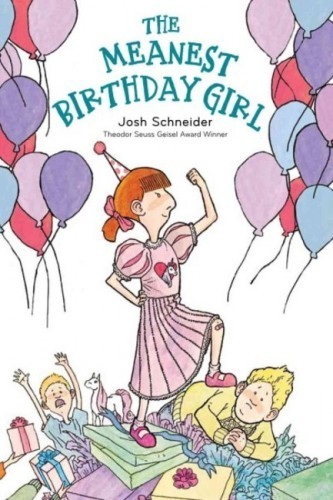 The Meanest Birthday Girl
The Meanest Birthday Girl
By Josh Schneider
Clarion Books (an imprint of Houghton Mifflin Harcourt)
$14.99
ISBN: 978-0-547-83814-4
Ages 6-9
On shelves now.
Life is easier when you can categorize it. When you can slot it in a distinct category and reduce everything to black and white terms. Gray is problematic and messy, after all. This type of thinking certainly applies to how people learn how to read. If you’re a library you separate your written fiction into five distinct locations: Baby & Board Books, Picture Books, Easy Readers, Early Chapter Books, and Middle Grade Fiction. Easy peasy. Couldn’t be simpler. And it would be an absolutely perfect system if, in fact, that was how humans actually learned how to read. Wouldn’t it be great if you could make mental leaps in difficulty from one book to another with sublime ease? Yet the fact of the matter is that for all that “leveling” a collection or trying to systematically give each book a Lexile reading level makes life easier for the folks who don’t want to bother to read the books themselves, it’s not so hotso for the kiddos. Not everything written in this world can be easily summarized. For this very reason I like books that don’t slot well. That are neither fish nor fowl. And I particularly like extraordinary books that fall into this category. Behold, then, the magnificent The Meanest Birthday Girl. Simple, straightforward, and smart as all get out, it’s too long for an easy book, too short for an early chapter book, and entirely the wrong size for a picture book. In other words, perfect.
As Dana sees it, birthdays are great for one particular reason. “It was Dana’s birthday and she could do whatever she liked.” Fortunately we’re dealing with a young kid here, so Dana’s form of Bacchanalian abandon pretty much just boils down to eating waffles for breakfast and dinner, showing off her birthday dress, and torturing fellow student Anthony. So it’s with not a little surprise that Dana finds at the end of the day that Anthony has shown up on her stoop with the world’s greatest birthday present. There, in the gleam of the house lights, stands a white elephant with pink toenails and a pink bow. Dana is elated and thinks that this is the best gift a gal could receive. It isn’t until she spends a little time with her white elephant gift that she begins to understand not just what a jerk she’s been, but how to spread the elephant “love” to those who need it the most.
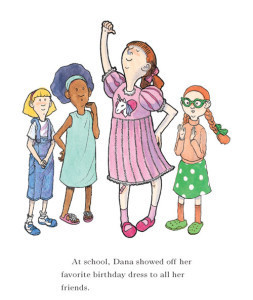 I’ll confess to you right here and now that sometimes when I’m reviewing a book I find it helpful to look at the professional reviews so that I can nail down exactly WHY it is I like such n’ such a book. I mean, I liked the art and the story and the characters here, sure. But what I really liked was what the book was trying to say. Small difficulty: I’m not entirely certain what that was. Is this a book about the selflessness of parenthood or is the elephant a metaphor of unchecked desires? So I turned to the professionals. PW said the book “both makes amends and pays it forward”. SLJ eschewed any complex interpretations just saying that this was “more a story about a girl and her pet than it is about birthday shenanigans”. The Horn Book Guide (the book didn’t even rate a proper Horn Book review) found the message confusing while Kirkus gave the book a star and saw the elephant as simply a delivery system for a lesson about kindness. None of these really do the plot justice, though. I sympathize with Horn Book Guide’s confusion, but I disagree that the message doesn’t make any sense. It just requires the reader to dig a little deeper than your average Goosebumps novel.
I’ll confess to you right here and now that sometimes when I’m reviewing a book I find it helpful to look at the professional reviews so that I can nail down exactly WHY it is I like such n’ such a book. I mean, I liked the art and the story and the characters here, sure. But what I really liked was what the book was trying to say. Small difficulty: I’m not entirely certain what that was. Is this a book about the selflessness of parenthood or is the elephant a metaphor of unchecked desires? So I turned to the professionals. PW said the book “both makes amends and pays it forward”. SLJ eschewed any complex interpretations just saying that this was “more a story about a girl and her pet than it is about birthday shenanigans”. The Horn Book Guide (the book didn’t even rate a proper Horn Book review) found the message confusing while Kirkus gave the book a star and saw the elephant as simply a delivery system for a lesson about kindness. None of these really do the plot justice, though. I sympathize with Horn Book Guide’s confusion, but I disagree that the message doesn’t make any sense. It just requires the reader to dig a little deeper than your average Goosebumps novel.
Here’s how I figure it. Dana’s mean. She’s given an elephant (I love the idea that Anthony, the victim, may have previously been himself a pretty nasty customer to have had the elephant in the first place). The elephant demands constant attention, but subtly. It could just be Dana’s projections of what the elephant wants that undo her. That means she’s capable of empathy, which in turn leads to her feeling bad for what she did to Anthony. And then much of why this book works as well as it does has to do with the fact that the elephant isn’t, itself, a bully. If it were then the message of the book would be pounded into your skull like a hammer on a nail. Far better then that this particular elephant is just quietly insistent. It isn’t incapable of emotion, mind you. I was particularly pleased with the look of intense concentration on its face as it attempts to ride Dana’s rapidly crumpling bicycle. The slickest elephant moment in the book visually is when its trunk makes a sly play for Dana’s sandwich when she falls asleep under a tree, but the last image as the elephant stands in front of its new owner is of equal note. There you’ll see its trunk making the gentlest of movements towards the girl’s slice of birthday cake. It doesn’t take a Nostradamus to know that that’s the last the girl will ever see of her cake from here on in.
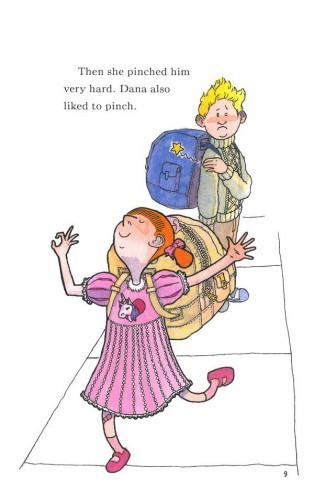 It was the PW review that probably did the best job of honing in on what makes this book special. Said they, the author “serves justice, [and] subtly (and quite cleverly) lets readers see another side to Dana …” That’s not something that occurred to me on an early reading but it’s entirely true. You meet Dana, her head resembling nothing so much in shape and size as those birthday balloons on the cover, and she does unlikable thing after unlikable thing. Then she gives up everything she has, from sandwiches to her bike, for a pachyderm. Kids may not make an immediate leap in logic between what Dana does and what they themselves sometimes have to do (willingly or unwillingly) for their little siblings, but it’s there. Schneider’s best move, however, is to show Dana being teased by a fellow classmate. Nothing cranks up the sympathy vote quite like someone suffering at the hands of another. Hence, by the time Dana formally apologizes to Anthony we’re completely Team Dana.
It was the PW review that probably did the best job of honing in on what makes this book special. Said they, the author “serves justice, [and] subtly (and quite cleverly) lets readers see another side to Dana …” That’s not something that occurred to me on an early reading but it’s entirely true. You meet Dana, her head resembling nothing so much in shape and size as those birthday balloons on the cover, and she does unlikable thing after unlikable thing. Then she gives up everything she has, from sandwiches to her bike, for a pachyderm. Kids may not make an immediate leap in logic between what Dana does and what they themselves sometimes have to do (willingly or unwillingly) for their little siblings, but it’s there. Schneider’s best move, however, is to show Dana being teased by a fellow classmate. Nothing cranks up the sympathy vote quite like someone suffering at the hands of another. Hence, by the time Dana formally apologizes to Anthony we’re completely Team Dana.
The art is all done in a simple execution of pen, ink, colored pencil, and watercolor. All of Schneider’s kids look like escapees from “L’il Orphan Annie” comic strips. They sport the same pupil-less eyes. Normally eyes without pupils are downright scary in some fashion, but Schneider shrinks them down so that they’re little more than incredibly expressive Os. Eyebrows go a long way towards conveying emotion anyway (the shot of Anthony raising one very cross eyebrow as Dana systematically nabs his cupcake is fantastic). Because Schneider’s books all have a tendency to look the same (Tales for Very Picky Eaters looks like The Meanest Birthday Girl looks like Princess Sparkle-Heart Gets a Makeover, etc.) there’s a temptation to discount him. Resist that urge. His is a star that is rising with rocket-like rapidity. I see great things for this guy. Great things.
The age level for this will cause no end of sorrow amongst the cataloging masses. I don’t care. The same could have been said for Sadie and Ratz (another preternaturally smart early early chapter book with a psychological base worth remembering) and a host of other books out there. What it all boils down to is the fact that The Meanest Birthday Girl is one of the rare books that makes for really intelligent fare. Odd? Certainly. But it’s willing to go places and do things that most books for kids in the 6-9 age range don’t dare. Not everyone will get what it’s trying to do. And not everyone deserves to. One of the best of 2013, bar none.
On shelves now.
Source: Final copy sent from publisher for review.
Like This? Then Try:
Sadie and Ratz by Sonya Hartnett
The Bad Birthday Idea by Madeline Valentine
Big Red Lollipop by Rukhsana Khan
Other Blog Reviews:
A Year of Reading
2ndgradereading
Professional Reviews:
A star from Publishers Weekly
A star from Kirkus
Booklist
The Montreal Gazette
The New York Times







